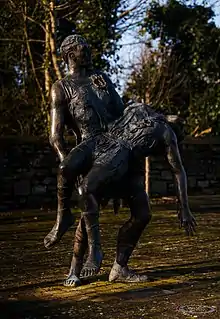Ferdiad
Ferdiad (pronounced [ˈfʲerðiað]; also Fer Diad, Ferdia, Fear Diadh), son of Damán, son of Dáire, of the Fir Domnann, is a warrior of Connacht in the Ulster Cycle of Irish mythology. In the Táin Bó Cúailnge, Ferdiad finds himself on opposite sides of the war to his best friend and foster-brother Cú Chulainn, with whom he had trained in arms under the renowned warrior woman Scáthach. He and Cú Chulainn are equal in all martial feats, with two exceptions: the Gáe Bulg, a barbed spear which Scáthach has taught only Cú Chulainn to use; and Ferdiad's horny skin, which no weapon can pierce.

When Ailill and Medb, king and queen of Connacht, invade Ulster to steal the bull Donn Cúailnge, their progress is held up by Cú Chulainn, who demands single combat. After Cú Chulainn has defeated a series of Connacht champions, Medb sends for Ferdiad, but he only agrees to fight Cú Chulainn after Findabair, Ailill and Medb's daughter, has seductively plied him with alcohol, and Medb has variously bribed, shamed and goaded him to do so. They fight in the ford for three days, first fighting with 8 swords, darts, and spears, then fighting with "throwing-spears" and lances, and finally moving on to "heavy, hard-smiting swords." It is on the third day that Ferdiad starts to gain the upper hand. At this point, Cú Chulainn calls to his charioteer, Laeg, for the Gáe Bolga, which he floats down the river to him. Cú Chulainn throws a light spear at Ferdiad's chest, causing him to raise his shield, and then picks up the Gáe Bolga between his toes and thrusts it through his anus upon which the barbs spread throughout his body, killing him. The Gáe Bolga is then removed from Ferdiad's body by Laeg, and Cú Chulainn mourns Ferdiad's death, praising his strength and bravery:
- "Ah, Ferdiad, betrayed to death."
- "Our last meeting, oh, how sad!"
- "Thou to die I to remain."
- "Ever sad our long farewell!"[1][2]
Scholars believe that the fight between Cú Chulainn and Ferdiad is a late addition to the Táin, originating not earlier than the eleventh century and drawing on earlier episodes in the story.[3]
Ferdiad's name has been interpreted as meaning "man of smoke", "man of the pair" or "man of two feet", and may be a back-formation from the placename Áth Fhir Diad (Ardee, County Louth) which is supposedly named after him.[3] His relationship with Cú Chulainn has been interpreted as having an erotic subtext.[4][5] Their relationship is characterised as a romantic one, as opposed to a friendly or a familial one, and their dialogue is unusually intimate, with "a vaguely homoerotic tone";[6] Ciarán Carson, in an endnote to his translation of The Táin, draws attention to the homoerotic symbolism of his death.[7]
Legacy

The ford on which he died is named Áth Fhirdiad (Ferdiad's ford in Irish) Ardee, County Louth is named after him (Baile Átha Fhirdhia).[8][9]
A bronze statue stands in Bridge Street, Ardee depicting the battle and the death of Ferdiad.[10][11]
References
- Joseph Dunn, "The Ancient Irish Epic Tale Táin Bó Cúalnge", London:David Nutt, 1914
- Ciarán Carson, The Táin, Pg 151
- Micheál Ó Flaithearta, "The Etymologies of (Fer) Diad", in Ruairi Ó hUiginn and Brian Ó Catháin (eds), Ulidia 2: Proceedings of the Second International Conference on the Ulster Cycle of Tales, An Sagard, 2009, pp. 218-225
- Sarah Sheehan, "Fer Diad De-flowered: Homoerotics and Masculimity in Comrac Fir Diad", in Ruairi Ó hUiginn and Brian Ó Catháin (eds), Ulidia 2: Proceedings of the Second International Conference on the Ulster Cycle of Tales, An Sagard, 2009, pp. 54-65
- Conner, Randy P. (1998). Cassell's Encyclopedia of Queer Myth, Symbol and Spirit. UK: Cassell. p. 116 "Cú Chulainn and Fer diadh". ISBN 0304704237.
- Cat Mount, "The Three Loves of Cúchulainn: The Impact of Warrior Relationships in The Táin", in T. E. Kinsella (ed.), Ulster Rising: Ten Essays on the Ulster Cycle, 2012, pp. 36-47
- Ciarán Carson, The Táin, Penguin Classics, 2007, p. 212-213
- Cecile O'Rahilly, Táin Bó Cúailnge Recension 1, Dublin Institute for Advanced Studies, 1976, pp. 195-208
- Cecile O'Rahilly, Táin Bó Cúalnge from the Book of Leinster, Dublin Institute for Advanced Studies, 1967, pp. 211-234
- "Where Ferdia fell: Ardee, Co Louth" (PDF). Archaeology Ireland Heritage Guide. 73: 6. Summer 2016.
- Ross. Noel (2011). "The Walled Town of Ardee: Selected Extracts." Journal of the County Louth Archaeological and Historical Society, 27 339-365. - via JSTOR
External links
 Media related to Ferdiad at Wikimedia Commons
Media related to Ferdiad at Wikimedia Commons